PowderMet 2011 Conference Report: Novel manufacturing technologies for high performance PM automotive applications
In the first of his exclusive articles for ipmd.net, Dr David Whittaker reports on presentations made by Ian Donaldson, GKN Sinter Metals, and Guenter Rau, PMG Fuessen, during the session on Materials for Automotive Applications.
A novel approach for manufacturing powder-forged connecting rods
The paper from Ian Donaldson, Timothy German and Raymond Williams (GKN Sinter Metals, USA) focussed on the manufacture of Powder Forged Connecting Rods.
In order to improve fuel consumption and to lower CO2 emissions, the automotive OEMs are driving a requirement to reduce the weight of moving engine components, including connecting rods.
Developments in the competing drop forged connecting rod technology have responded to this challenge by adopting material changes either to higher carbon contents (which also reduce as-forged ductility to offer the ability to fracture-split the big-end cap) or to micro-alloyed rather than plain-carbon grades. These materials develop higher tensile and fatigue strengths than their predecessors on direct air cooling after forging.
The challenge for the manufacturers of Powder Forged (PF) connecting rods has been to match or even exceed these fatigue property improvements while maintaining good machinability.
Material choices
The traditional material of choice for PF connecting rods has been an elemental mix including 2% admixed copper, 0.4-0.6% graphite and an addition of MnS for improved machinability.
Previous work reported by these authors had identified that the most effective route to increasing strength level was to increase Cu content while adjusting the ratios of C and Cu to balance strength improvements with machinability. However, if the higher Cu content is introduced entirely through ad-mixed additions, the ensuring of a uniform distribution of copper throughout the PF microstructure (and hence consistent and reliable properties) becomes problematic because of the kinetics of diffusion and some free Cu may even be present. The use of higher processing temperatures and times might be a means of improving this situation but with negative impacts on energy consumption and process costs. The use of pre-alloyed Cu iron powder, as an alternative to admixing elemental Cu, has therefore been investigated and developed as an innovative route to improving chemical homogeneity and consistency of properties.
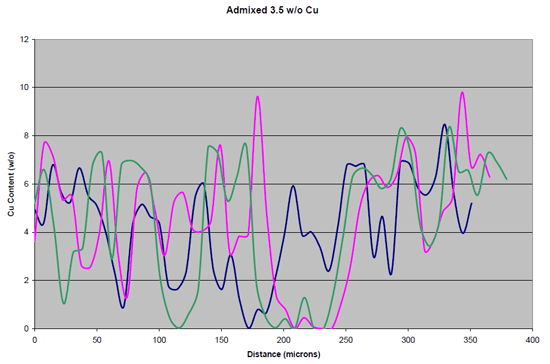
Fig. 1 Cu line scans for the material with 3.5% admixed Cu (As presented by I. Donaldson, GKN Sinter Metals, USA, at PowderMet2011. Courtesy MPIF)
Initial work, previously reported by these authors, had evaluated the influence of progressive replacement of admixed Cu with pre-alloyed Cu on compressibility during the forming of connecting rod preforms. This work concluded that, although reductions in compressibility were observed, a 3% Cu material based entirely on a pre-alloyed addition still achieved an adequate green density level.
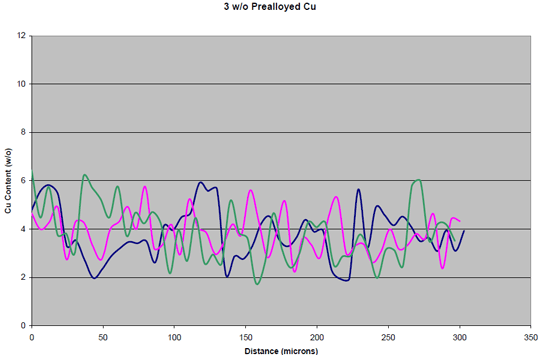
Fig. 2 Cu line scans for the material with 3% pre-alloyed Cu (As presented by I. Donaldson, GKN Sinter Metals, USA, at PowderMet2011. Courtesy MPIF)
Work reported in the current paper began with an assessment of Cu distribution in the as-forged material, using SEM/EDX line scans on metallographic samples. The measured distribution, for a material with 3.5% admixed Cu processed at 1135°C, (Fig. 1) showed wide variations in Cu content from very low (non-detectable) to very high (around 10%). Similar evaluations on this material processed at higher temperatures (1230 and 1260°C) showed only minor improvements in this situation. However, significantly lower variations in Cu were measured for a material containing 3% pre-alloyed Cu (Fig. 2). Also, a similar low variation was observed for a material containing 3% pre-alloyed Cu and a further 1% admixed Cu (Fig. 3), indicating that the 3% pre-alloyed Cu material could be used as an effective base for varying Cu content above 3%.
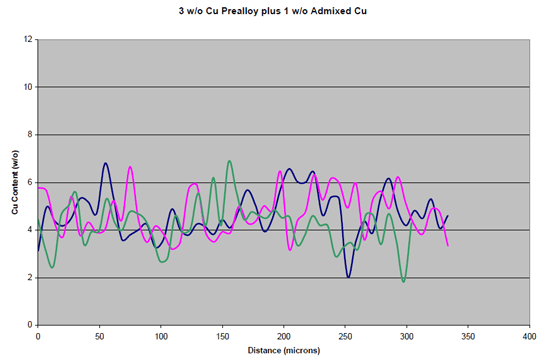
Fig. 3 Cu line scans for the material with 3% pre-alloyed Cu and 1% admixed Cu (As presented by I. Donaldson, GKN Sinter Metals, USA, at PowderMet2011. Courtesy MPIF)
Fatigue properties
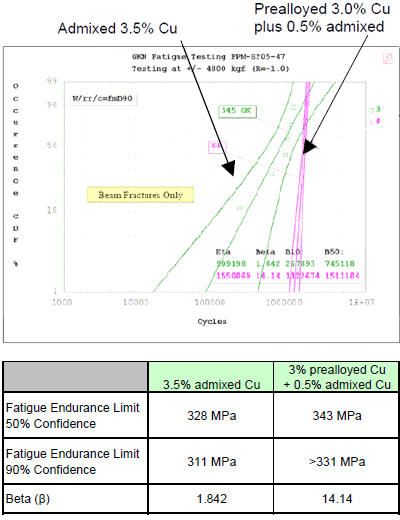
Fig. 4 Weibull analyses of fatigue performance of materials
with 3.5% admixed Cu and with 3% pre-alloyed Cu + 0.5% admixed
Cu (As presented by I. Donaldson, GKN Sinter Metals, USA, at
PowderMet2011. Courtesy MPIF)
Axial fatigue test results were reported on test bars, machined from the I-beam section of connecting rods and tested at a stress ratio of R = -1 (fully reversed loading). Additional fatigue testing was carried out on connecting rod components. These were axial staircase tests on a servo-hydraulic rig under constant load, again at R = -1, to determine mean endurance limit. Constant load testing produced Weibull statistics to provide a direct comparison between the different material variants.
The axial fatigue results showed that a 3% pre-alloyed Cu material gave an increase of endurance limit of 10% compared with a baseline 2% admixed copper material at a carbon level around 0.6% (399 vs 362 MPa) and that the admixed addition of a further 0.5%Cu to the 3% prealloyed material gave a further significant increase in endurance limit to 466 MPa (i.e. 29% higher than the 2% Cu baseline material).
Further, statistical analysis using a Weibull distribution has shown the significant improvement in the reliability in fatigue performance on replacing a fully admixed 3.5% Cu grade with one based on a 3% pre-alloyed Cu material with a further 0,5% admixed Cu.(Fig. 4)
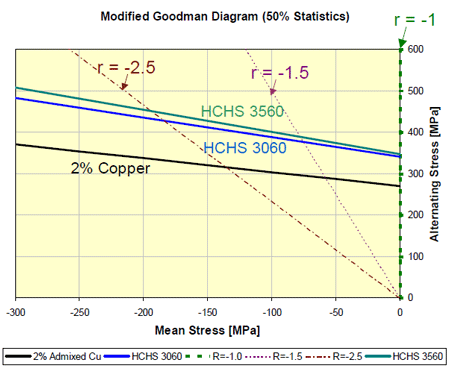
Fig 5 A modified Goodman diagran showing the fatigue strengths of three selected materials over a range of R-ratios (As presented by I. Donaldson, GKN Sinter Metals, USA, at PowderMet2011. Courtesy MPIF)
Also, in order to provide a basis for comparison of fatigue performance over a full spectrum of stress ratios (R), this paper also presented a modified Goodman diagram (Fig. 5). This figure shows the significant improvement in fatigue life at various R ratios, compared with a 2% admixed Cu material, offered by samples designated HCHS 3060 (3% pre-alloyed Cu + 0.6% C) and HCHS 3560 (3% pre-alloyed Cu, 0.5% admixed Cu + 0.6%C).
Conclusions
There is strong evidence, therefore, that the reported alloying developments offer a reliable and flexible means of targeting the desired improvements in fatigue performance, tensile properties and machinability, in a process route that utilises existing PF production equipment.
High performance PM synchroniser rings with carbon friction linings
The second paper was from Guenter Rau and Patrice Delarbe (PMG Fuessen, Germany) and featured high performance PM synchroniser rings for use in manual and dual clutch transmissions (DCT).
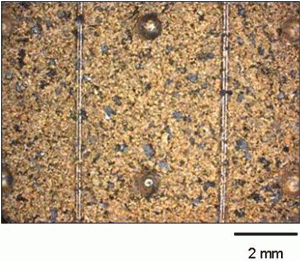
Fig. 6 Sintered friction material (As presented
by G Rau, PMG Fuessen, Germany at
PowderMet2011. Courtesy MPIF)
While threaded brass synchroniser rings dominated the market for many years, the limited strength of brass has meant that they have been superseded as performance demands have risen. PMG have developed high performance PM sintered hardened products, using an Fe -1.5%Mo-4%Ni-2%Cu-0.6%C material, to serve this market. Sintered metal friction linings, consisting of brass and bronze powder with friction and lubricating additives sprinkled and sintered onto a sheet metal (Fig. 6), have been bonded to these products using the company’s CD-welding process. More recently, carbon fabric friction linings have been increasingly used. Fig. 7 shows the structure of a plain woven carbon fabric with a specific carbon fibre impregnated with a resin. PMG bond carbon fabric linings to synchroniser rings using their own proprietary process.
Material testing
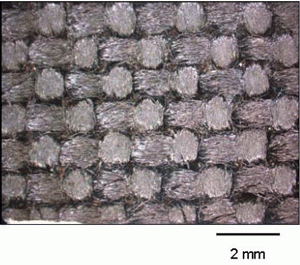
Fig. 7 Carbon fabric friction material (As
presented by G Rau, PMG Fuessen, Germany
at PowderMet2011. Courtesy MPIF)
The objective of this paper was to compare, in similar test conditions, the performance of carbon and sintered friction material in single and double cone systems over a range of operating conditions (pressure, sliding speed, oil type).
Test rings were prepared and were endurance tested in complete synchroniser system assemblies using a ZF/FZG-SSP180 rig. These tests used two different lubricants from different suppliers, Oil A (a transmission oil) and Oil B (a well-established double clutch transmission oil).
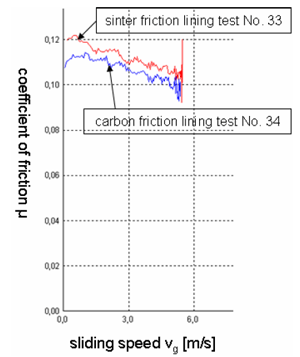
Fig. 8 Coefficient of friction/sliding speed plots for
shift 50,000 in Oil A (As presented by G Rau, PMG
Fuessen, Germany at PowderMet2011. Courtesy
MPIF)
Both friction linings gave similar, very stable performance in terms of minimum and average coefficients of friction, axial force, frictional torque and travel of the sliding sleeve, in the tests using Oil A. Fig. 8 is a plot of coefficient of friction against sliding speed at shift 50,000 in the tests and shows that, at relatively low pressure (5.6 N/mm²) and low sliding speed (5.6 m/s), the sintered material shows higher friction behaviour than the carbon material.
However, the results of the tests with Oil B (Fig. 9) showed that, in this case, the carbon lining performed better than the sintered material. The carbon material sustains higher sliding speed than the sintered material, although pressure had to be reduced from 6 N/mm² to 4 N/mm² for the carbon material.
These sets of results indicated that the carbon lining is sensitive to pressure, whereas the sintered lining is sensitive to sliding speed. Also, the type of gear oil has a significant influence on friction behaviour i.e. coefficient of friction is sensitive to the oil additives.
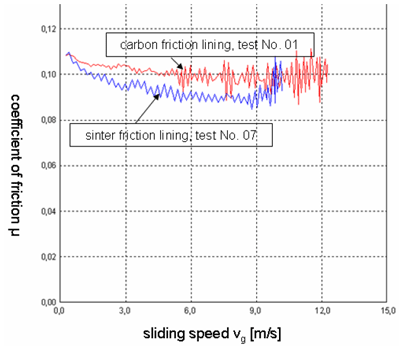
Fig. 9 Coefficient of friction/sliding speed plots for shift 50,000 in Oil B (As presented by G Rau, PMG Fuessen, Germany at PowderMet2011. Courtesy MPIF)
The first and second gears (and sometimes the third and fourth gears) are equipped with double or triple cone systems for shifting comfort. In order to assess the performance of carbon friction material in a double cone system (using a design variant with linings on the inner side of the outer and intermediate rings), positive endurance tests were performed in a further manual transmission oil, Oil C. At the end of the test, 130,000 cycles had been reached without failure. The coefficient of friction was very stable during testing (Fig. 10).
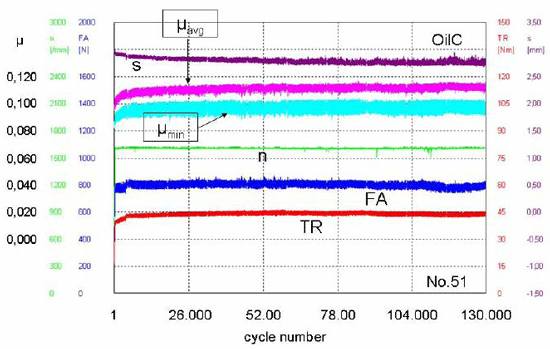
Fig. 10 Endurance test, carbon friction lining, double cone system, Oil C (As presented by G Rau, PMG Fuessen, Germany at PowderMet2011. Courtesy MPIF)
Conclusions
The overall conclusion from the reported study was that, in the current context of high demand for improved friction torque and shifting comfort, multiple synchroniser systems are increasingly being specified and the additional flexibility given by carbon linings can make a significant contribution to the design of high performance, low cost and more effective systems.
Author: Dr David Whittaker is a consultant to the Powder Metallurgy and associated industries. Contact +44 1902 338498 email: [email protected]
News | Articles | Market reviews | Search directory | Subscribe to e-newsletter





